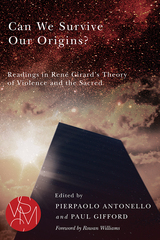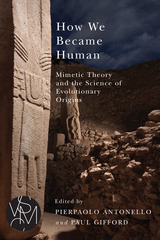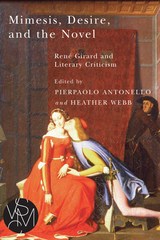3 books about Antonello, Pierpaolo

Can We Survive Our Origins?
Readings in René Girard's Theory of Violence and the Sacred
Pierpaolo Antonello
Michigan State University Press, 2015
Are religions intrinsically violent (as is strenuously argued by the ‘new atheists’)? Or, as Girard argues, have they been functionally rational instruments developed to manage and cope with the intrinsically violent runaway dynamic that characterizes human social organization in all periods of human history? Is violence decreasing in this time of secular modernity post-Christendom (as argued by Steven Pinker and others)? Or are we, rather, at increased and even apocalyptic risk from our enhanced powers of action and our decreased socio-symbolic protections? Rene Girard’s mimetic theory has been slowly but progressively recognized as one of the most striking breakthrough contributions to twentieth-century critical thinking in fundamental anthropology: in particular for its power to model and explain violent sacralities, ancient and modern. The present volume sets this power of explanation in an evolutionary and Darwinian frame. It asks: How far do cultural mechanisms of controlling violence, which allowed humankind to cross the threshold of hominization—i.e., to survive and develop in its evolutionary emergence—still represent today a default setting that threatens to destroy us? Can we transcend them and escape their field of gravity? Should we look to—or should we look beyond—Darwinian survival? What—and where (if anywhere)—is salvation?
[more]

How We Became Human
Mimetic Theory and the Science of Evolutionary Origins
Pierpaolo Antonello
Michigan State University Press, 2015
From his groundbreaking Violence and the Sacred and Things Hidden since the Foundation of the World, René Girard’s mimetic theory is presented as elucidating “the origins of culture.” He posits that archaic religion (or “the sacred”), particularly in its dynamics of sacrifice and ritual, is a neglected and major key to unlocking the enigma of “how we became human.” French philosopher of science Michel Serres states that Girard’s theory provides a Darwinian theory of culture because it “proposes a dynamic, shows an evolution and gives a universal explanation.” This major claim has, however, remained underscrutinized by scholars working on Girard’s theory, and it is mostly overlooked within the natural and social sciences. Joining disciplinary worlds, this book aims to explore this ambitious claim, invoking viewpoints as diverse as evolutionary culture theory, cultural anthropology, archaeology, cognitive psychology, ethology, and philosophy. The contributors provide major evidence in favor of Girard’s hypothesis. Equally, Girard’s theory is presented as having the potential to become for the human and social sciences something akin to the integrating framework that present-day biological science owes to Darwin—something compatible with it and complementary to it in accounting for the still remarkably little understood phenomenon of human emergence.
[more]

Mimesis, Desire, and the Novel
Rene Girard and Literary Criticism
Pierpaolo Antonello
Michigan State University Press, 2015
Fifty years after its publication in English, René Girard’s Deceit, Desire, and the Novel (1965) has never ceased to fascinate, challenge, inspire, and sometimes irritate, literary scholars. It has become one of the great classics of literary criticism, and the notion of triangular desire is now part of the theoretical parlance among critics and students. It also represents the genetic starting point for what has become one of the most encompassing, challenging, and far-reaching theories conceived in the humanities in the last century: mimetic theory. This book provides a forum for new generations of scholars and critics to reassess, challenge, and expand the theoretical and hermeneutical reach of key issues brought forward by Girard’s book, including literary knowledge, realism and representation, imitation and the anxiety of influence, metaphysical desire, deviated transcendence, literature and religious experience, individualism and modernity, and death and resurrection. It also provides a more extensive and detailed historical understanding of the representation of desire, imitation, and rivalry within European and world literature, from Dante to Proust and from Dickens to Jonathan Littell.
[more]
READERS
Browse our collection.
PUBLISHERS
See BiblioVault's publisher services.
STUDENT SERVICES
Files for college accessibility offices.
UChicago Accessibility Resources
home | accessibility | search | about | contact us
BiblioVault ® 2001 - 2024
The University of Chicago Press









